
|
In The Phantom's Shadow
and
The Phantom’s Long Shadow
|

|
|
In The Phantom's Shadow
By Michael Moore, Reprinted from the
1990 Issue of the Chrysler
300 Club News
Volume XVI Number II
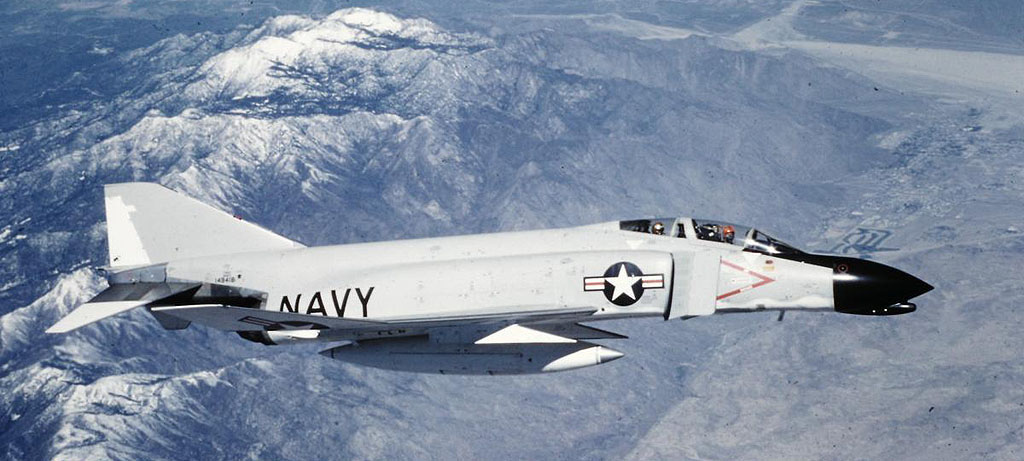
Our H will always belong to
 Commander Carl Benjamin Austin. He was a Naval Aviator. Carl flew the hottest fighter the Navy had in the 60's; the F4H Phantom II. We lost Carl shortly before Christmas 1965 over North Vietnam, 11 days before his 42nd birthday.
Commander Carl Benjamin Austin. He was a Naval Aviator. Carl flew the hottest fighter the Navy had in the 60's; the F4H Phantom II. We lost Carl shortly before Christmas 1965 over North Vietnam, 11 days before his 42nd birthday.
We ended up with his car, a half empty pack of Luckies, and a note where he had checked his gas mileage during his Thanksgiving leave of '65.
I used to wonder what went through this Phantom pilot's mind when he drove the 300H; I know he was at home in it. The Walter Mitty part of me used to wonder how coming down the Colorado Boulevard on-ramp onto I-5 in second gear compared to coming off the starboard catapult of the Saratoga in a Phantom (0 to 180 in 2.5 seconds!). When I passed a hot '57 Chevy on highway 395 at 135, I wondered if the driver felt like a MIG-21 pilot who had just been had.
For a number of years, Commander Austin was listed as MIA. I always thought that if he made it back, we'd return his car. But he made the wall instead.
It became our car. We moved around the country and raised two kids and a couple of Weimaraners in it. We moved with it from LA to Dallas, to Melbourne, Florida, to Quincy, Illinois, and finally back to Los Angeles. (We had the car at its original dealer's town in Corvallis, Oregon last year, but the dealership was long gone.)
While we were finishing up my degree in Florida in 1974, we went to the public oyster beds every Wednesday to get washtubs of free oysters. The washtubs spilled saltwater into the trunk. The trunk floor has the scars of its 1986 replacement.
Until it got new rear springs in 1988, the car had a sag in the rear developed from hauling heavy furniture from Greenwood, Mississippi to Los Angeles for a friend in 1966.
One night in 1967 I was out "partying" with a friend and unintentionally took out a chain link fence. And so I learned that the brakes on the H are a far cry from arresting gear. (But then, don't fighter planes go into the barrier sometimes?) Although it got extensive attention at the time, those scars remained (ripples in the fenders) until 1986; unpleasant reminders of youthful indiscretion.
The fan and the radiator became non-original when the fan clutch came apart in Texas, with Connie, on the way home from Girl Scout camp. She drove the car at least 10 miles with the fan blade buried in the radiator…no water, no air flow. It was running pretty rough when it came home, but it was OK when it cooled off.
The engine seized one winter in Illinois in 1982. We stored the car in a barn. We moved to California. We left the car with the finest mechanic is Quincy, Illinois; Lee Hamilton's Racing Engines. For two years, we mailed money. Finally, in 1986, we flew back for graduation from college for our daughter and son. The car was mechanically superb, but the body and interior looked like hell. Rats had lived in it during storage. Rust had gotten to the rear quarters and front lower fenders. I thought Connie was going to cry. I was able to get a fine body shop, Bill Hanley's, to work night and day to clean up the rust, weld in steel and paint the car. They did a good job under the circumstances, and at least the car was suitable for ferrying to California without being ashamed (fighter pilots are proud!) A lot of things didn't work; some windows, gauges, and the brakes were stranger than I remembered. But we had a wonderful vacation ferrying the H home. Walter Mitty wondered if Carl Austin had ever had to ferry a Phantom II home without everything working right. I'm sure he did, but at least we weren't dealing with bullet holes or SAMS.
Once home, we started fixing some of the cars problems. It was as though we were the only people in the world with a Letter Car. I sent a letter in response to an ad in a magazine for interiors. I couldn't afford the couple of hundred I THOUGHT it would take for an "interior", but I really needed a power window motor. I got a response and Connie went to get the motor. She came back excited about all the "stuff" this guy sold and how neat his interiors were. Also, he had warned about "getting the disease." I was flabbergasted at the costs; this was clearly not Pep Boys or J C Whitney league!
Then we happened upon a car show with a lot of 300s in it, and they looked really good. My bride pointed out that if our H could look that nice again, maybe we wouldn't need to buy a new car, since ours was mechanically sound now.
Soon, we had rationalized our way into buying a complete interior from Gary Goers. Along the way, we discovered we should replace our dash pad. I was also pretty edgy about continuing to drive with the patched up dash and engine compartment wiring harnesses. They both had burned up a couple of times and I'd patched them. (A lot of old fighters need to be patched up.)
We decided that we really ought to get the whole car properly repainted, since we had a new interior. We started getting a better understanding of "the disease" Gary had warned us about.
When we decided that we would "take the car apart", we decided to use our living room as a staging area. We didn't want to forget that we had the car apart! I had a terrible fear of getting the car apart and losing interest or whatever and having a basket case on my hands for the next 10 years. (What could I ever say? Carl, I forgot how to put your car back together?) We bought a 20 ft x 20 ft tarpaulin and put all the car parts on it in geographical order as they were on the car. The living room soon filled up. But we NEVER forgot about the car!
The body was sent to the body shop. I didn't remove the engine. The shop welded in replacement steel for some of the rust damage. They did a beautiful job of the original Oyster white in polyurethane paint. While the body was out for a few months, we started looking at the chrome. It went out for replating. We received a lot of comments about "the car in our living room" from everyone who came to our house that year! As the seats came back from having the Goers kit installed, they were replaced in their respective spots on the living room floor.
By now, we were aware that there were other Letter Cars in the world, and had become well acquainted with Chip Chapman, 300 Club H consultant. I can't say enough for the help that we got from Chip and Kathy. It really gets lonely sometimes when every parts store and wrecking yard in town has laughed you out the door because of the ridiculous part you're trying to find. But it's so good to be able to talk to someone else who has had the problem and knows how to fix it! Chip talked us through many a tough problem. But most of all, his moral support helped us through those lonely and scary times when the world thinks you've taken leave of your senses to spend perfectly good money on an old junky car.
Finally, IT came home. It was like one long Christmas putting all the like-new shiny parts back on the new shiny IT. IT wasn't really a car yet, but it was more than a body. It was during the long assembly time that I came to the realization that you have to do every single assembly task perfectly, because if you don't, you can build a huge lemon all by yourself. If you change a fan belt, and leave one bolt loose, you'll usually know as soon as you drive it. The worst that happens is you go back and tighten all the bolts. But if you've spend months putting hundreds of bolts back together and you just have a small percentage loose or somehow wrong, you won't know until you drive the whole car at once. You could have done hundreds of things wrong!
Once we realized this, we became compulsive about doing everything right. Another task could not be started until the one at hand was done properly. All hardware was Locktited. The less accessible it would be, the more Locktite it got. Tiny problems got major attention. I spend hours working with the heater control valve switch, assemble and disassemble, on and on, until it was right. The turn signal switch which never locked was finally fixed with Chips advice. The mystery of why the air conditioning was never cool was solved. And so it went. Parts didn't go back on until they were right.
|
My bride of 28 years was truly an able partner in this endeavor. Although she started out handing wrenches, before long she was installing, polishing, and assembling. She not only did a lot of the work, but also quickly learned about things automotive. She was not only the team conscience ("Is that the way its supposed to go on?") but also the number one parts procurer and ultimately the project manager. Our license plate frame says "Connie's Beautiful Brute" and she means it.
|
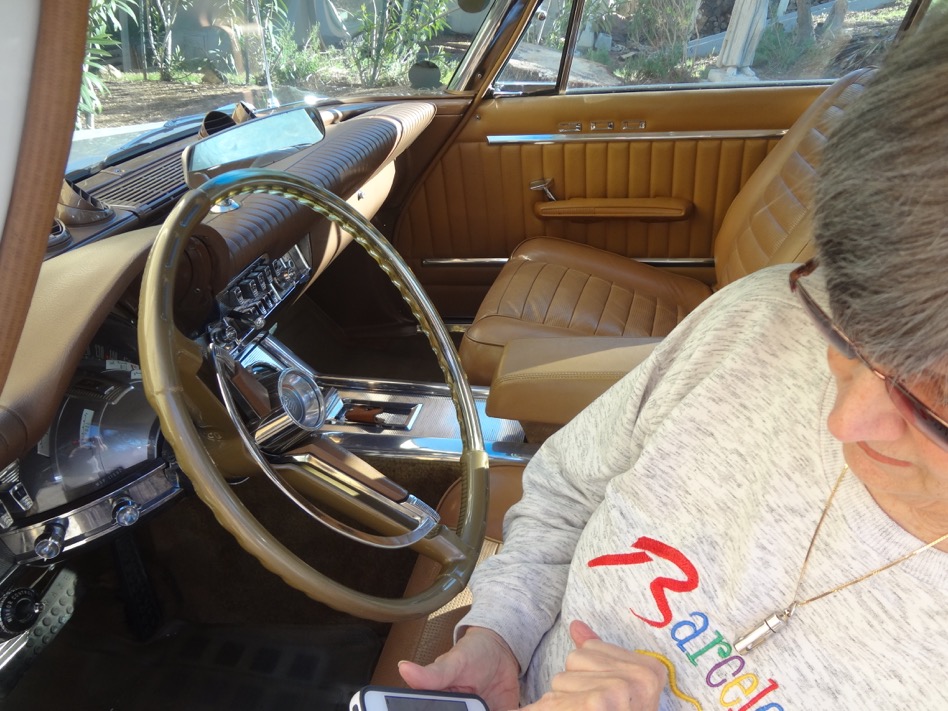
|
Finally IT was together. The one thing we immediately noticed was that it was much quieter. There were no rattles. We have taken the car on vacation two years now to shows; we have yet to have it to a 300 Club International show, but we will. We love our car, we love driving it, and we enjoy the memories that it holds for us.
On July 5, 1989, near the Oregon border in northern California, we rolled the odometer over for the third time. On the same trip, we noticed a flight of Oregon Air Guard Phantoms landing in formation. This is the last year that the Oregon Air Guard flies Phantoms; and I thought about Commander Carl Benjamin Austin, USN, from Woodburn, Oregon and hoped that he'd be proud of his car.
BEAT ARMY
|
The
Phantom’s Long Shadow
By Michael Moore, January 2016
In 1990, I
wrote an article about the history of our 300H, and how we bought it
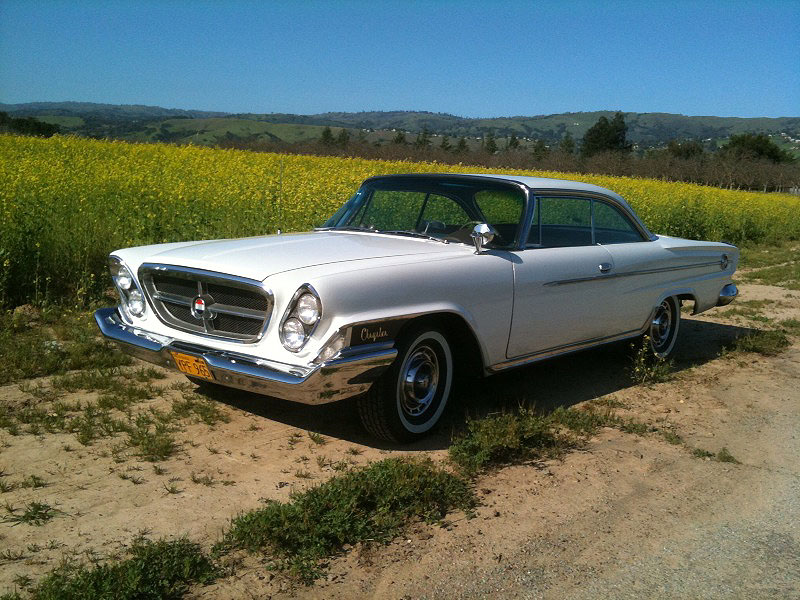 at a historic time in American history, the Vietnam War.
I was recently asked, since I’m still around and so is the car, to
write an update to the story. Ironically, in a few weeks, it will be
50 years since we acquired it. I have a love for history and a great
respect for heroes, so please read on as I also expand the bio of the
previous owner, Cdr. Carl Benjamin Austin as I have learned more
about him since 1990. at a historic time in American history, the Vietnam War.
I was recently asked, since I’m still around and so is the car, to
write an update to the story. Ironically, in a few weeks, it will be
50 years since we acquired it. I have a love for history and a great
respect for heroes, so please read on as I also expand the bio of the
previous owner, Cdr. Carl Benjamin Austin as I have learned more
about him since 1990.
But first,
I will tell you about the car:
THE CAR
We had
restored the car (our family car) ourselves in 1984. I had been
greatly encouraged by Chip Chapman. It had earlier traveled with us
from Glendale, Ca to Dallas, Tx (1967) to Melbourne, Fla (1972),
Quincy, Illinois (1975), then back to Simi Valley,California (1982), and
on to Morgan Hill, Ca. (1996). It made a memorable 6 week cross
country vacation from LA to Birmingham to Norfolk to Greenup Ill and
back to California in the summer of 1966 with our two small children.
We later showed it, winning trophies in Los Angeles, Victoria BC and
Bend Oregon. Like most people, we soon found the car show camaraderie
more important than the cars or the trophies.
We had a valve
recession problem on a return trip from a WPC show in Victoria, BC.
Connie and I pulled both heads in Ray Doern’s backyard in
Portland, Oregon and had hardened seats installed overnight. After a
day’s work, a celebratory steak dinner with our hosts the
Doerns, we left the second morning. A few years later we moved to the
hills of Morgan Hill, California.
 The Chrysler’s rear bumper
dragged going into the garage of the steep driveway unless I removed
the other cars and put the Chrysler in first diagonally, followed by
considerable in-garage maneuvering to place it against the wall.
We drove it much less then because of this nuisance. The Chrysler’s rear bumper
dragged going into the garage of the steep driveway unless I removed
the other cars and put the Chrysler in first diagonally, followed by
considerable in-garage maneuvering to place it against the wall.
We drove it much less then because of this nuisance.
A flash
of glory came when Chrysler Corp borrowed the car to use in the
introduction of one of the later non-letter 300 series in the late
90’s. They sent a truck and crew up into our rural roads,
picked up the car, detailed it, and used it at a Pebble Beach display
of 300’s. My wife and her guests received free tickets to
Pebble Beach Concours while I commiserated in England on a business
trip.
I was not
satisfied with the brakes or the erratic idle. I suspected the bad
idle was related to the custom camshaft installed earlier. Booster
Dewey in Portland discovered we had an inadequate single diaphragm
NAPA booster instead of the as delivered factory dual diaphragm power
brake booster. We bought ourselves a rebuilt dual diaphragm correct
booster for Christmas that year. It improved the brakes
significantly.

 I have been on a major campaign the last few years to
get the car correctly roadworthy, including a major brake job (new
cylinders everywhere), rebuilt correct dual diaphragm booster,
rebuild of brake backing plate adjusters, rebuilt engine mounts, new
sway bar bushings, rebuilt steering box, new shocks, fan clutch, u
joints, third member rebuild for Sure-Grip clutch pack, axles and
bearings (axle threads were stripped), carb restoration, front wheel
bearings, emergency brake shoes etc. I was surprised and happy to
discover new tires of a closer- to- stock size resulted in no
further bumper dragging getting in and out of the garage. We would
be more likely to drive the car.
I have been on a major campaign the last few years to
get the car correctly roadworthy, including a major brake job (new
cylinders everywhere), rebuilt correct dual diaphragm booster,
rebuild of brake backing plate adjusters, rebuilt engine mounts, new
sway bar bushings, rebuilt steering box, new shocks, fan clutch, u
joints, third member rebuild for Sure-Grip clutch pack, axles and
bearings (axle threads were stripped), carb restoration, front wheel
bearings, emergency brake shoes etc. I was surprised and happy to
discover new tires of a closer- to- stock size resulted in no
further bumper dragging getting in and out of the garage. We would
be more likely to drive the car.
In an
effort to solve the idle issue, I had both carbs “restored”
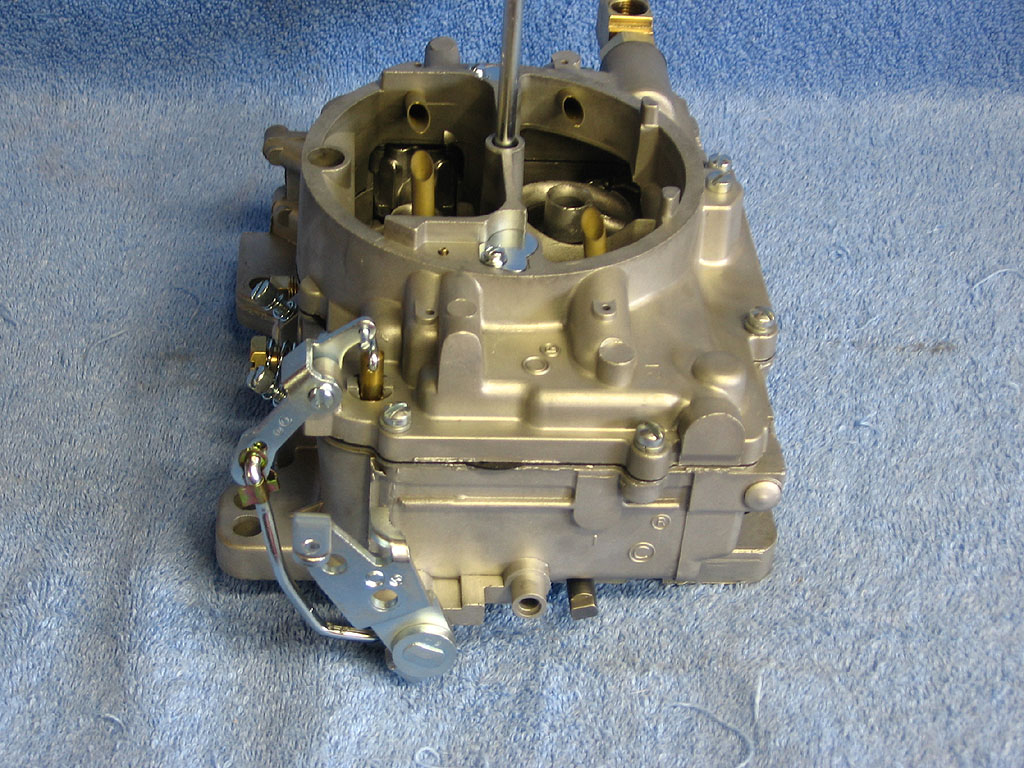 to resolve bent linkage issues among other evils. I also located a
300H camshaft from a fellow club member (not yet installed.) I
recently discovered a major intake manifold vacuum leak thanks to
suggestions from club members. This may be causing the erratic idle.
When I get the car back on the road, it will be because of the many
club members and especially the support of Gary Goers, Jeff Carter
and Chuck Hill. We greatly appreciate all their patience. to resolve bent linkage issues among other evils. I also located a
300H camshaft from a fellow club member (not yet installed.) I
recently discovered a major intake manifold vacuum leak thanks to
suggestions from club members. This may be causing the erratic idle.
When I get the car back on the road, it will be because of the many
club members and especially the support of Gary Goers, Jeff Carter
and Chuck Hill. We greatly appreciate all their patience.
THE HISTORY
They
shall grow not old, as we that are left grow old: Age shall not weary
them, nor the years condemn. At the going down of the sun and in the
morning, We will remember them “ -Laurence Binyon-For the
Fallen
The car
was originally purchased by Cdr. Carl Austin’s father- in- law,
James Chester Raines. Cdr Austin’s family car was a 47
Plymouth. When Mr. Raines passed away, the 300H was given to the
Austins, who also kept the 47 Plymouth. After Cdr. Austin’s
loss, the 300H was traded in for a new Burgundy Chevrolet Caprice.
I never
knew details about Cdr. Austin or his family, except I knew he had
chosen a life of service to our country, which put him at the top of
my list of noble people.
I had no knowledge of the previous owner of the car until I tried to
register the car after I bought it. That was why I had to have a
copy of “DD-1300 Report of Casualty”. It was several
months until I got license plates for the car. That was how I learned
who the previous owner was and approximately how he was lost.
Being the the son of a Naval Aviator myself,
and growing up on naval and military bases around the world, I
understood losses of aviator fathers, so frequent in the 50’s
and felt emotional ties to the Austin’s loss.
I was
excited to receive a note in 2015 from Jim Austin, Carl’s son,
previously unknown to me, who was living in Malaysia.
 Jim had seen a
note to his dad I had left on Find-a-Grave in which I said I had
the car. Jim and I communicated. He asked and I sent him pictures of
the car. Jim remembers the sounds of the carburetors and the exhaust
when his dad had to “blow it out” sometimes. His sister
Jacqui, who lives in Seattle, also saw the pictures and was
interested in seeing the interior which she remembers. Jim had seen a
note to his dad I had left on Find-a-Grave in which I said I had
the car. Jim and I communicated. He asked and I sent him pictures of
the car. Jim remembers the sounds of the carburetors and the exhaust
when his dad had to “blow it out” sometimes. His sister
Jacqui, who lives in Seattle, also saw the pictures and was
interested in seeing the interior which she remembers.
Jim pointed
out some errors in my first article, dealing with when I acquired the
car. We had actually bought it in Feb 1966. Cdr. Austin was lost in
Dec 1965. The F4H also became the F4 when Navy changed the
nomenclature protocol. Jim believes his father was flying the F4B
version.
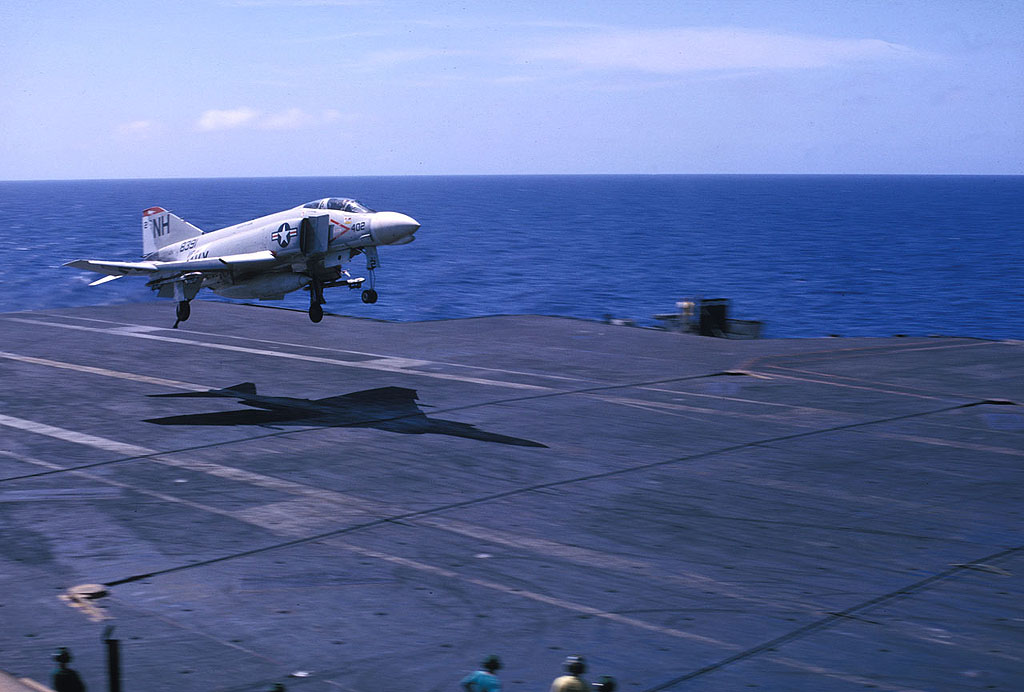 Carl was 5 years younger than my Dad and had flown in Korea
off Princeton. (My Dad had also flown in Korea. Jim and I wonder if
they had ever met.) Cdr. Austin gained notoriety during the Korean
War for dropping a kitchen sink on the North Koreans. I have attached
a photo of the infamous kitchen sink incident. Jacqui also pointed
out some errors, notably I had his birthdate wrong. He was born on
Sept 13, not Dec 13.
Carl was 5 years younger than my Dad and had flown in Korea
off Princeton. (My Dad had also flown in Korea. Jim and I wonder if
they had ever met.) Cdr. Austin gained notoriety during the Korean
War for dropping a kitchen sink on the North Koreans. I have attached
a photo of the infamous kitchen sink incident. Jacqui also pointed
out some errors, notably I had his birthdate wrong. He was born on
Sept 13, not Dec 13.
“VA-195
Dambusters was assigned to Carrier Air Group 19 (CVG-19) for a
deployment to the Korean War from 21 March to 03 November 1952. The
"special weapon" was a 454 kg (1000 lb) bomb with a kitchen
sink attached. The idea came up, when the squadron's executive
officer LCDR M.K. Dennis remarked during a meeting with the press:
"We dropped everything on them (the North Koreans) but a kitchen
sink." Royal J. Deland, ADC, and J. Burnett, ADC, then produced
a bomb with a kitchen sink attached. The commanding Admiral was not
pleased by this and would not allow to drop the bomb for a week.
However, press coverage in the United States obviously led to the
dropping of this bomb in August 1952 on Pyongyang by Lt.(jg) Carl B.
Austin.”
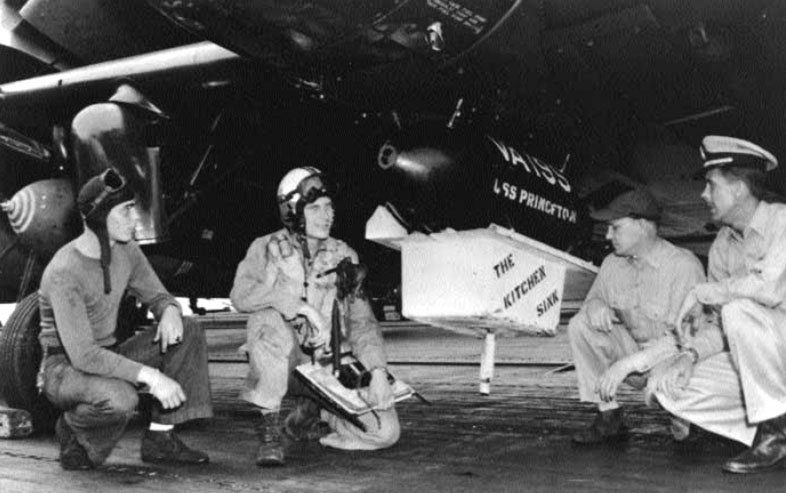
In
December of 1965, Commander Austin, an experienced combat pilot and
Squadron CO of VA-114 “Fighting AArdvarks” launched on a
mission from the USS Kitty Hawk, CVA-63 on Yankee Station. According
to reports, with Lt (jg) Jacob Drummond Logan, they apparently flew
into low clouds. While reversing course to get out of the clouds and
return to sea, they flew into a mountain 10 miles south of Mu Ron Ma,
Vietnam. Both pilots were lost. Jacqui knows the location and is
planning to visit the zone of impact.
Cdr.
Austin was a warrior and a hero who paid the ultimate price for all
of us. Heroes go to war willingly. They go because our country needs
them. I am honored and proud to be the caretaker of Cdr. Austin’s
car. Jacqui pointed out, (I strongly agree), the families of
veterans, irrespective of service or war, pay a devastating price
with the combat loss of a soldier or sailor who is a spouse, parent,
or child. The family’s loss is too seldom recognized. It is a
loss survivors never get over. It hurts my heart when I think about
what Peggy, Jacqui and Jim had to deal with. They are a testimony to
the strength of the human spirit and I am glad, and proud, to finally
know them both.

Back
|
|